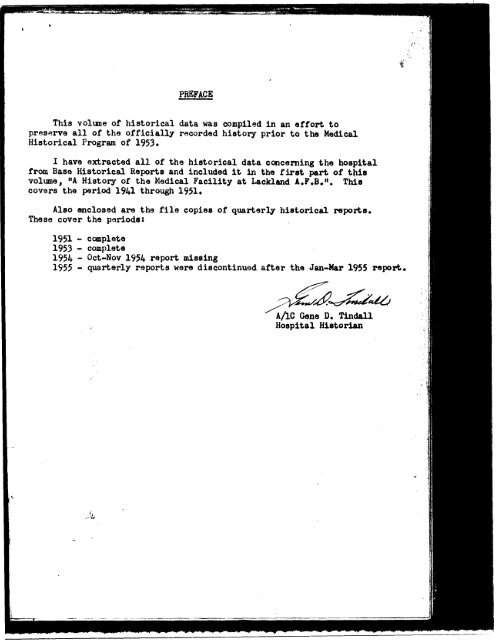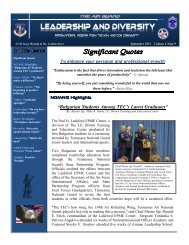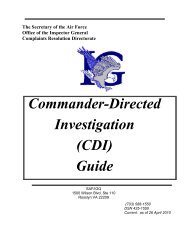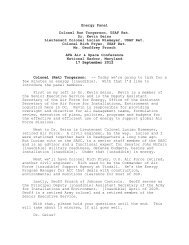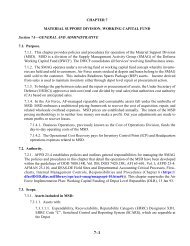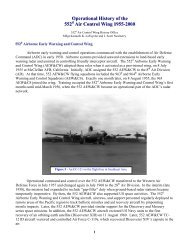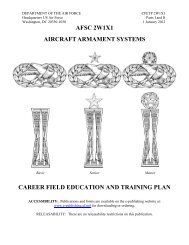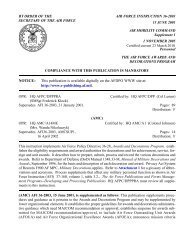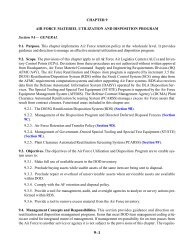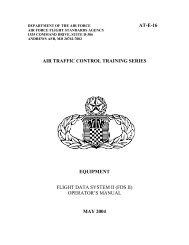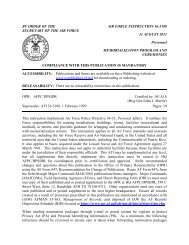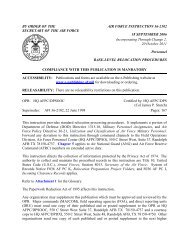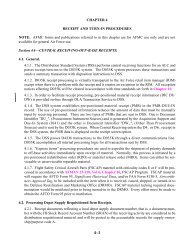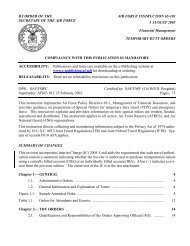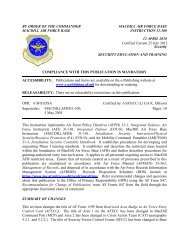History of the Medical Facility at Lackland AFB ... - Air Force Link
History of the Medical Facility at Lackland AFB ... - Air Force Link
History of the Medical Facility at Lackland AFB ... - Air Force Link
You also want an ePaper? Increase the reach of your titles
YUMPU automatically turns print PDFs into web optimized ePapers that Google loves.
I<br />
I<br />
PREFACE<br />
This volume <strong>of</strong> historical d<strong>at</strong>a was compiled in an effort to<br />
preserve all <strong>of</strong> <strong>the</strong> <strong>of</strong>ficially recorded history prior to <strong>the</strong> <strong>Medical</strong><br />
Historical Program <strong>of</strong> 1953.<br />
I have extracted all <strong>of</strong> <strong>the</strong> historical d<strong>at</strong>a concerning <strong>the</strong> hospital<br />
from Base Historical Reports and included it in <strong>the</strong> first part <strong>of</strong> this<br />
volume, "A <strong>History</strong> <strong>of</strong> <strong>the</strong> <strong>Medical</strong> <strong>Facility</strong> <strong>at</strong> <strong>Lackland</strong> A.F.B.". This<br />
covers <strong>the</strong> period 1941 through 1951.<br />
Also enclosed are <strong>the</strong> file copies <strong>of</strong> quarterly historical reportu.<br />
These cover <strong>the</strong> periods:<br />
1951 - complete<br />
1953 - complete<br />
195L - - - Oct-Nov 195L re~ort misainn<br />
s.7 - - . - =-- -<br />
1955 - quarterly reports were diaiontinued after <strong>the</strong> Jan-Mar 1955 report.<br />
/ A/~C Gene D. Tindall<br />
Hoapital Historian
A WTSTORY OF THE MEDICAL FACILITY AT LACKLAM3 <strong>AFB</strong><br />
(The following d<strong>at</strong>a has been extracted from historical d<strong>at</strong>a reports on<br />
file in <strong>the</strong> Hi<strong>at</strong>orical Section <strong>of</strong> <strong>the</strong> Winn --- Adlutant -"----- 1s - Divisi --------. nn , . /I q70CH.h --r..<br />
MUitary Training Wing, <strong>Lackland</strong> ~i-r <strong>Force</strong> Base, Sen Antonio, Teus)<br />
The facility was built in two separ<strong>at</strong>e sections. Construction<br />
wae began on <strong>the</strong> first section on 15 June 19W. This section was released<br />
by Amy engineers to <strong>the</strong> Base <strong>Air</strong> Install<strong>at</strong>ions Office, on 25 Hay 1942.<br />
The second section <strong>of</strong> <strong>the</strong> hospital was released by Axmy engineers to <strong>the</strong><br />
Base <strong>Air</strong> Install<strong>at</strong>ions Office in October 1962 with a few building8 released<br />
in January 1943 ,<br />
Ths medical unit pressntly occupied by <strong>the</strong> USAF Hospital is an<br />
outgrowth <strong>of</strong> <strong>the</strong> St<strong>at</strong>ion Hospital, a unit <strong>of</strong> <strong>the</strong> San Antonio Avi<strong>at</strong>ion<br />
Cadet Center, The AAF Regional. and St<strong>at</strong>ion Hospital was design<strong>at</strong>ed by<br />
WD Circular 187, 26 June 1942, under <strong>the</strong> cnmmnnd <strong>of</strong> Col, John R.<br />
Copenhagen, Direct or <strong>of</strong> <strong>Medical</strong> Services . The hospital began oper<strong>at</strong>ions<br />
on 8 June 1942 when <strong>the</strong> San Antonio Avi<strong>at</strong>ion Cadet Center was directly<br />
under <strong>the</strong> control <strong>of</strong> Kelly Field, On 4 July 1942, <strong>the</strong> hoepital, along<br />
with o<strong>the</strong>r units <strong>of</strong> <strong>the</strong> San Antonio Avi<strong>at</strong>ion Cadet Center, became an<br />
independent command with Col. Robert J Pl<strong>at</strong>t , USAAF, HC assumring<br />
command <strong>of</strong> <strong>the</strong> medical activity July 1942. In addition to <strong>of</strong>fering <strong>the</strong><br />
usual services <strong>of</strong> a St<strong>at</strong>ion Hospital during <strong>the</strong> year 19@, a completely<br />
equipped - -.-.. Dental Clinic was in oper<strong>at</strong>ion. As an additional misrion, <strong>the</strong><br />
-- ---"- - - -- -.<br />
hospital also trained selected medical <strong>of</strong>ficera in <strong>the</strong> School <strong>of</strong> Avi<strong>at</strong>ion<br />
Medicine along with a <strong>Medical</strong> Training Center School for enlisted men,<br />
wherein auch courses a8 Field Sanit<strong>at</strong>ion, First Aid, Field Harpital and<br />
Comb<strong>at</strong> Rescue, and o<strong>the</strong>r rel<strong>at</strong>ed sub ject8 were taught.<br />
In addition to <strong>the</strong> St<strong>at</strong>ion Hospital loc<strong>at</strong>ed in <strong>the</strong> north end<br />
<strong>of</strong> <strong>the</strong> field, five dispensaries were in oper<strong>at</strong>ian in variow amas <strong>of</strong> <strong>the</strong>
Base undor <strong>the</strong> command <strong>of</strong> Flight Surgeon who commanded <strong>the</strong> <strong>Medical</strong><br />
Processing activity in <strong>the</strong>ir respective areas. Major Edwin C. Benjamin<br />
war surgeon <strong>of</strong> <strong>the</strong> Army <strong>Air</strong> <strong>Force</strong> Preflight School, and Lt. Col, William<br />
H. Lawton, was chief Flight Surgeon <strong>of</strong> <strong>the</strong> Classific<strong>at</strong>ion Section.<br />
In 1943, <strong>the</strong> St<strong>at</strong>ion Hospital boasted more than 1,200 bedr, lM<br />
<strong>Medical</strong> processing <strong>of</strong> aircrew candid<strong>at</strong>es and avi<strong>at</strong>ion cadets,<br />
corrective surgery on aircraw candid<strong>at</strong>es, and <strong>the</strong> oper<strong>at</strong>ion <strong>of</strong> a branch<br />
school <strong>of</strong> Avi<strong>at</strong>ion Medicine were <strong>the</strong> main functions.<br />
On 1 February 1946 with <strong>the</strong> wartime miasion <strong>of</strong> Training Avi<strong>at</strong>ion<br />
cadets completed, <strong>Lackland</strong> became known as <strong>the</strong> Army <strong>Air</strong> <strong>Force</strong> Military<br />
Training Center, and <strong>the</strong> hospital <strong>at</strong> this time was design<strong>at</strong>ed as an<br />
Army <strong>Air</strong> <strong>Force</strong> Regional and Convalescent Hospital. In Januarg 1946,<br />
<strong>the</strong> Hospital was under <strong>the</strong> camaand <strong>of</strong> Colonel Clyde L, Bro<strong>the</strong>rs, MC, <strong>at</strong><br />
which time <strong>the</strong> medical activities <strong>of</strong> <strong>the</strong> St<strong>at</strong>ion Hoapital on Kellg. Field<br />
were transferred to <strong>the</strong> AAF Regional and Convaleacent Hospital <strong>at</strong> <strong>Lackland</strong>.<br />
In February <strong>of</strong> <strong>the</strong> same year, <strong>the</strong> medical services <strong>of</strong> Brooks Field,<br />
Texaa, were transferred to this activity.<br />
DUD to tho convsrsion <strong>of</strong> hckland (<strong>the</strong>n San Antonio Avi<strong>at</strong>ion<br />
Cadst Center) from Avi<strong>at</strong>ion Cadet Tra3ni.g to Basic Hilitarg Indoctrin<strong>at</strong>ion<br />
Training, a gre<strong>at</strong> increase in Hospital admission was ahown during <strong>the</strong><br />
January-March 1946 period, This was due to <strong>the</strong> increased nmber <strong>of</strong><br />
personnel on <strong>the</strong> field and <strong>the</strong> concentr<strong>at</strong>ion no doubt <strong>of</strong> "Teen-Agersn<br />
who had not previously been exposed to a variety <strong>of</strong> contagious diseases,<br />
4amWE-h.1~d-&-<br />
or who had not been subjected to or experienced <strong>the</strong> usual run <strong>of</strong> childhood<br />
sicknesses.
During ths January-April 1946 period ths following popul<strong>at</strong>ion<br />
figures for <strong>the</strong> hospital are reflectedt<br />
Number <strong>of</strong> Wards Census Monthly Admissions<br />
January<br />
February<br />
March<br />
April<br />
7<br />
10<br />
12<br />
16<br />
349<br />
62 5<br />
643<br />
842<br />
-<br />
5%<br />
770<br />
1,378<br />
During this time <strong>the</strong> medical services consisted <strong>of</strong> 13 medical <strong>of</strong>ficers<br />
and me administ r<strong>at</strong> ive assistant,<br />
<strong>Lackland</strong> continued to grow, and continued to train baric airmen.<br />
a<br />
In midd948, Colonel J. R. copenha&, Base Surgeon, looked over hie<br />
sprawling, war relic <strong>of</strong> a Base Hospital, which encompassed 112 single<br />
story fram buildings, where 32 ove-worked physiclane had to wdk miles<br />
and milas as <strong>the</strong>y tried to do <strong>the</strong> work <strong>of</strong> <strong>the</strong> 38 doctors which <strong>the</strong><br />
hospital was supposed to have. Everyone, it reaned, was coming into <strong>the</strong><br />
<strong>Air</strong> <strong>Force</strong> except <strong>the</strong> medical men, who were all going out, The surgeon<br />
thought his nomal 439 cases a day were more than enough; and although<br />
health conditions <strong>of</strong> <strong>the</strong> Base popul<strong>at</strong>ion were surprisingly good, <strong>Lackland</strong>' s<br />
proneness towards <strong>at</strong>ypical pneumonia was dust anothsr reason for viewing<br />
<strong>the</strong> overcrowding <strong>of</strong> personnel with concern. The Medioal Squadron and 3700th<br />
St<strong>at</strong>ion Hospital were design<strong>at</strong>ed by General Ordera 79, 25 August 1948,<br />
The most pressing problem <strong>of</strong> <strong>the</strong> Hospital during <strong>the</strong> last halt<br />
<strong>of</strong> 1948 was <strong>the</strong> serious shortage <strong>of</strong> medical <strong>of</strong>ficers, At <strong>Lackland</strong> <strong>AFB</strong><br />
38 medical <strong>of</strong>ficers were authorieed. On 1 July 1948, only 34 yere assigned.<br />
On 31 Decmbar 1948 only 29 were aaaignsd. At hckland's hospital during<br />
1948 <strong>the</strong>re were 11,944 actmissions with <strong>the</strong> daily average <strong>of</strong> hospital p<strong>at</strong>ient6<br />
<strong>of</strong> 439. Out-P<strong>at</strong> isnt visits (including dental, eta) totalled 195,618.<br />
Furthsrmore, <strong>the</strong> doctore assigned to <strong>the</strong> hospital during this period had
to do <strong>the</strong>ir work in a sprawling hoapital unit consisting <strong>of</strong> 112 single<br />
story frame buildings grouped over a rel<strong>at</strong>ively large area,<br />
At <strong>Lackland</strong>'s hospital during <strong>the</strong> first aix months <strong>of</strong> 1949<br />
thwe was a total <strong>of</strong> 5,515 admissions to <strong>the</strong> hospital. The out-p<strong>at</strong>ient<br />
clinic totalled 49,443 military visits and 9,779 non-militarg visits.<br />
This volume <strong>of</strong> business was conducted with a msdical <strong>of</strong>ficer staff <strong>of</strong><br />
30. As <strong>of</strong> 1 January 1949, 17 Dental <strong>of</strong>ficers were aseigned with 14<br />
being assigned as <strong>of</strong> 30 June 1949. This serious loss <strong>of</strong> medically trained<br />
psraonnel prompted <strong>the</strong> surgeon to st<strong>at</strong>e in June 1949 th<strong>at</strong> Itif tho lose<br />
<strong>of</strong> medical <strong>of</strong>ficers continued <strong>at</strong> <strong>the</strong> past r<strong>at</strong>e, <strong>the</strong> activities <strong>of</strong> this<br />
hospital will have to be reduced to sick call, dispensary tre<strong>at</strong>ment,<br />
and <strong>the</strong> examin<strong>at</strong>ion <strong>of</strong> incoming trainees." It was <strong>the</strong> consensus <strong>of</strong><br />
opinion <strong>at</strong> this time th<strong>at</strong> it would be most uns<strong>at</strong>isfactory to transport<br />
personnel from <strong>the</strong> St<strong>at</strong>ion Hoepitol <strong>at</strong> <strong>Lackland</strong> to o<strong>the</strong>r hospitals <strong>at</strong><br />
nearby install<strong>at</strong>ions, and th<strong>at</strong> <strong>the</strong> abaence <strong>of</strong> adequ<strong>at</strong>e medical care and<br />
immedi<strong>at</strong>e surgical and medical services for emergency cases on <strong>Lackland</strong><br />
would n<strong>at</strong> only prove a8 a bad morale factor on <strong>the</strong> basic trainee popul<strong>at</strong>ion,<br />
but would constitute a health haaard.<br />
During <strong>the</strong> mid part <strong>of</strong> 1949 <strong>the</strong> shortage <strong>of</strong> <strong>Medical</strong> <strong>of</strong>ficers <strong>at</strong><br />
<strong>the</strong> hospital reachsd a more serious level when <strong>the</strong> Surgeon was informed<br />
th<strong>at</strong> in addition to furnishing medical services for <strong>the</strong> entire popul<strong>at</strong>ion<br />
on <strong>Lackland</strong> h~ would be responsible for <strong>the</strong> processing and hospitalis<strong>at</strong>ion<br />
<strong>of</strong> p<strong>at</strong>ienta from <strong>the</strong> newly re-opened Ellington <strong>Air</strong> <strong>Force</strong> Base Jut outside<br />
<strong>of</strong> Houston, Texas, The situ<strong>at</strong>ion became so critical in October 1949 th<strong>at</strong><br />
in an interview <strong>the</strong> Surgeon made <strong>the</strong> et<strong>at</strong>ement Itit is <strong>the</strong> aim <strong>of</strong> <strong>the</strong><br />
Surgeon and his staff to practice <strong>the</strong> highest possible standards <strong>of</strong><br />
medicine in spite <strong>of</strong> <strong>the</strong> critical shortage <strong>of</strong> personnel; however, all<br />
IIII-c---
indic<strong>at</strong>ions are th<strong>at</strong> in order to continue <strong>the</strong> barest miniru <strong>of</strong> oper<strong>at</strong>ions<br />
<strong>the</strong> standards <strong>of</strong> medical practice will fall mle8s additional phyaicima<br />
rsport to this <strong>at</strong><strong>at</strong>ion.#<br />
On 10 February 1950 <strong>the</strong> Cammanding General, 3700th AFIW (which<br />
was design<strong>at</strong>ed on 00 79, ATRC, 25 October 19491, L<strong>AFB</strong>, was notified by<br />
'I'WlC from <strong>the</strong> Commanding General, <strong>Air</strong> Training Command, th<strong>at</strong> <strong>the</strong> activity<br />
known as tha St<strong>at</strong>ion Hospital was being reduced to a dispsnc)ary st<strong>at</strong>w<br />
with <strong>the</strong> target d<strong>at</strong>e set for <strong>the</strong> middle <strong>of</strong> June 1950. Plans were<br />
hdi<strong>at</strong>ely made by <strong>the</strong> Surgeon and 8taff to transfer all militaxy dependento<br />
to Brooke Amy <strong>Medical</strong> Center loc<strong>at</strong>ed on Fort Sam Howton, Te-8,<br />
P<strong>at</strong>ients who were found t o be in need <strong>of</strong> hospitaliz<strong>at</strong>ion beyond <strong>the</strong><br />
target d<strong>at</strong>e were also being transferred to Brooke Army <strong>Medical</strong> Center,<br />
and <strong>the</strong> policy th<strong>at</strong> only those p<strong>at</strong>ients who required a minimum <strong>of</strong> 72<br />
hours <strong>of</strong> hospitalia<strong>at</strong>ion would be admitted to <strong>the</strong> <strong>Lackland</strong> activity.<br />
This reduction in service n<strong>at</strong>urally called for ths conaolid<strong>at</strong>ion <strong>of</strong><br />
activities and plans wsre made by <strong>Air</strong> Install<strong>at</strong>iona to close a number<br />
<strong>of</strong> buildings in <strong>the</strong> hospital area,<br />
With this reduction in activity a neceaeary reduction in<br />
psrsonnsl was effacted. When notific<strong>at</strong>ion was received <strong>of</strong> <strong>the</strong> cbge in<br />
<strong>the</strong> hospital's st<strong>at</strong>us, 128 civilian smployees were on duty, A8 <strong>of</strong> 15 June<br />
1950 only 49 <strong>of</strong> th<strong>at</strong> number remained.<br />
On 16 June 1950 orders (GO 50, Hq, L<strong>AFB</strong>, Par 1) were issued which<br />
in part st<strong>at</strong>ed, "...The 3700th St<strong>at</strong>ion Hospital, <strong>Lackland</strong> <strong>Air</strong> <strong>Force</strong> Base,<br />
San Antonio, Texas, is redesign<strong>at</strong>ed <strong>the</strong> USAF Infirmary eff 2400, 16<br />
June 1950."
With all plans made to oper<strong>at</strong>e <strong>the</strong> facility as an infirmary,<br />
inform<strong>at</strong>ion was received l<strong>at</strong>er th<strong>at</strong> <strong>the</strong> Secretary <strong>of</strong> Defense had authorised<br />
continued oper<strong>at</strong>ion <strong>of</strong> <strong>the</strong> facility as a United St<strong>at</strong>es <strong>Air</strong> <strong>Force</strong><br />
Hospital with a bed capacity <strong>of</strong> 100. All instructions frm Headquarters,<br />
United St<strong>at</strong>es <strong>Air</strong> <strong>Force</strong> pertaining to <strong>the</strong> reduction <strong>of</strong> <strong>the</strong> hospital to<br />
an inf innary were rescinded,<br />
Shortly after <strong>the</strong> issuance <strong>of</strong> general orders on 16 June 1950,<br />
and <strong>the</strong> subsequent cancell<strong>at</strong>ion <strong>the</strong>re<strong>of</strong>, <strong>the</strong> incident on <strong>the</strong> 38th parallel<br />
occurred, Within 45 days instruction8 were received fran <strong>the</strong> aifice <strong>of</strong><br />
<strong>the</strong> <strong>Air</strong> Surgeon giving authority to <strong>the</strong> Commanding Officer <strong>of</strong> <strong>the</strong> 3700th<br />
Mqdical Group to set up a 475 bed hospital which was to provide all types<br />
<strong>of</strong> definitive care within <strong>the</strong> capacity <strong>of</strong> <strong>the</strong> personnel and equipment<br />
available, This action @.aced <strong>the</strong> hospital closer to <strong>the</strong> st<strong>at</strong>us th<strong>at</strong> it<br />
occupied in March 1950. The problam facing <strong>the</strong> Surgeon <strong>of</strong> re-equipping<br />
various technical facilities for <strong>the</strong> p<strong>at</strong>ient load was knor canpared<br />
to <strong>the</strong> re-assembling <strong>of</strong> his pr<strong>of</strong>eeaional staff as it had existed in<br />
March 1950, Admiasions to <strong>the</strong> hospital during <strong>the</strong> month <strong>of</strong> August 1950<br />
amounted to 702; <strong>the</strong>se admissions plus personnel received for elas8lfic<strong>at</strong>ion<br />
and transferred to Brooke Anny Medioal Center for hospitalis<strong>at</strong>ion and<br />
medical processing <strong>of</strong> <strong>the</strong> grs<strong>at</strong> numbers <strong>of</strong> <strong>Air</strong> <strong>Force</strong> recruits th<strong>at</strong> flooded<br />
this st<strong>at</strong>ion during mid 1950 were conducted with an understaffed pr<strong>of</strong>essional<br />
service.<br />
The following was <strong>the</strong> staffing personnel situ<strong>at</strong>ion in <strong>the</strong><br />
3700th <strong>Medical</strong> Group during <strong>the</strong> month <strong>of</strong> September 1950:
I Beninninn 1 Sep 50 Endinn 30 Sep 50 Gains Los8ea<br />
AFNC I WHSC -<br />
I <strong>Air</strong>men<br />
Civilians<br />
365<br />
75 86 il<br />
I USAF 2 2 1<br />
In addition to <strong>the</strong> routine duties <strong>of</strong> which <strong>the</strong> hospital was<br />
required to give personnel <strong>of</strong> <strong>Lackland</strong> <strong>the</strong> additional duty <strong>of</strong> providing<br />
temporary tre<strong>at</strong>ment for Korean war casualties was asaimed to <strong>the</strong><br />
Surgeon on 1 September 1950. In <strong>the</strong> initial stages, <strong>the</strong> <strong>Lackland</strong><br />
hospital served as an overnight rest stop for <strong>the</strong> wounded who had been<br />
flown from Hickam Field, Hawaii, or Travis <strong>Air</strong> <strong>Force</strong> Base, California,<br />
to Kelly <strong>AFB</strong>, while enroute to military hospitals throughout <strong>the</strong><br />
country.<br />
On 11 December 1950, <strong>the</strong> <strong>Lackland</strong> hospital acquired an even<br />
more important role in <strong>the</strong> <strong>Air</strong> Evacuee Program, which was charged with<br />
bringing wounded warrior8 fraa <strong>the</strong> b<strong>at</strong>tlefront to <strong>the</strong> well equipped<br />
military hospitals in <strong>the</strong> United St<strong>at</strong>es. On th<strong>at</strong> d<strong>at</strong>e, <strong>Lackland</strong> was<br />
design<strong>at</strong>ed a major port <strong>of</strong> debark<strong>at</strong>ion for <strong>the</strong> Korean returnees. The<br />
capacity <strong>of</strong> <strong>the</strong> hospital was ordered increased from 475 to 1,000 beds,<br />
This move caught <strong>Lackland</strong> medical <strong>of</strong>f iciale completely by<br />
surprise. They had but recently prepared a table <strong>of</strong> distribution for a<br />
725 bed hospital and were formul<strong>at</strong>ing <strong>the</strong>ir plane for expansion on <strong>the</strong> basis <strong>of</strong><br />
this proposal. They had anticip<strong>at</strong>ed th<strong>at</strong> only 125 <strong>of</strong> <strong>the</strong> 725 beds<br />
would be required by <strong>the</strong> evacuees, whereas, <strong>the</strong> Washington directive<br />
decreed th<strong>at</strong> 500 beds be alloc<strong>at</strong>ed for this purpose.
The evacuees began streaming into <strong>Lackland</strong> before <strong>the</strong> hospital<br />
was fully ready to receive <strong>the</strong>m, Washington provided eassntial personnel<br />
to handle this influx by 30 to 60 day TDY from o<strong>the</strong>r bases. <strong>Lackland</strong><br />
<strong>of</strong>ficials bsgan a program to recruit its own personnel t o supplant <strong>the</strong><br />
TDY people when <strong>the</strong>y left. Additional doctors were obtained and ambulance<br />
drivers were recruited from<strong>the</strong> Base Motor Pool. In order to man <strong>the</strong><br />
program adequ<strong>at</strong>ely, it was expectedth<strong>at</strong> saw 1,300 persons would be<br />
required, This represented a substantial increase over previous strength<br />
requirement 8,<br />
The increased need for medical administr<strong>at</strong>ive personnel<br />
for medical corpsmen resulted in a sub<strong>at</strong>antially altered table nf<br />
distribution. The augmented administr<strong>at</strong>ive force was required because<br />
<strong>Lackland</strong> was charged with <strong>the</strong> responsibility <strong>of</strong> preparing individual<br />
case reports and with forwarding <strong>the</strong>m to Washington. On <strong>the</strong> basis <strong>of</strong><br />
<strong>the</strong>se reports , Washington determined <strong>the</strong> ult h<strong>at</strong>e di sposition <strong>of</strong> <strong>the</strong><br />
p<strong>at</strong>ients.<br />
The n<strong>at</strong>ure <strong>of</strong> <strong>the</strong> tre<strong>at</strong>ment provided by <strong>Lackland</strong> demanded<br />
<strong>the</strong> assignment <strong>of</strong> approxim<strong>at</strong>ely twice <strong>the</strong> number <strong>of</strong> medical corpamen<br />
as were required for <strong>the</strong> normal hospital routine. To relieve <strong>the</strong><br />
critical shortage - <strong>of</strong> <strong>the</strong>se corpsmen, a school to train a consignmmt -<br />
<strong>of</strong> basic trainees was held, No airmen were assigned to <strong>the</strong> wards<br />
medical corpsmen until after <strong>the</strong>y had completed this training.<br />
The p<strong>at</strong>ients received supportive ra<strong>the</strong>r than remedial tre<strong>at</strong>ment<br />
<strong>at</strong> <strong>Lackland</strong>, The first necessary tre<strong>at</strong>ment had already been provided.<br />
Mainly, <strong>Lackland</strong> fed, shaved, ba<strong>the</strong>d, paid, and replaced <strong>the</strong> dresringe
and damaged casts <strong>of</strong> <strong>the</strong> Korean casualties. Quite a few blood tran8fusions<br />
were given, To facilit<strong>at</strong>e this activity, <strong>Lackland</strong> started its awn<br />
blood bank r<strong>at</strong>hsr than storing <strong>the</strong> blood <strong>at</strong> Brooke Am Hospital as was<br />
previously done, Surgical tre<strong>at</strong>ment was available but was provided<br />
only when necessary. Only those p<strong>at</strong>ients requiring emergemcy tre<strong>at</strong>m<strong>at</strong><br />
remained <strong>at</strong> <strong>Lackland</strong> longer than 48 hours,<br />
Between 1 September 1950 and 11 January 1951, more than 3,500<br />
comb<strong>at</strong> men were cared for <strong>at</strong> <strong>the</strong> <strong>Lackland</strong> Hospital, During <strong>the</strong> month<br />
<strong>of</strong> December only, sane 1,200 wounded men were received.<br />
From 11 December 1950, when <strong>Lackland</strong> was design<strong>at</strong>ed a maJor<br />
debark<strong>at</strong>ion port, to 10 January 1951, 2,774 evacuees poured into <strong>the</strong><br />
base ho'spital. Once <strong>the</strong> program was in full oper<strong>at</strong>ion, a daily average<br />
<strong>of</strong> 150 p<strong>at</strong>ients streamed into <strong>the</strong> hospital, while <strong>the</strong> outward flaw<br />
avoraged about 100.<br />
As <strong>of</strong> 31 December 1950 <strong>the</strong> assigned and authorized strength<br />
<strong>of</strong> <strong>the</strong> 3700th <strong>Medical</strong> Group was:<br />
Assimed Authorized<br />
MC 32<br />
MSC 16 15<br />
VC 2 1<br />
WMSC 2 5 -<br />
AFNC 43 50<br />
USAF 3 0<br />
Enlisted 713 422<br />
Civilian 128 172<br />
During <strong>the</strong> month <strong>of</strong> January 1951 when <strong>Lackland</strong> underwent <strong>the</strong><br />
Blits, and was investig<strong>at</strong>ed by congressional investig<strong>at</strong>ors, civilians I<br />
I appointed by <strong>the</strong> President, and <strong>the</strong> <strong>Air</strong> Surgeon and his <strong>at</strong>aff, <strong>the</strong>
hospital, still under strength, experienced a high r<strong>at</strong>e <strong>of</strong> admissions<br />
due to high trainee receipts during th<strong>at</strong> time. On 19 Januarg 1951,<br />
<strong>the</strong> Surgeon, Col. Robert E. Lee, announced th<strong>at</strong> military nurses would<br />
serve a duty tour <strong>of</strong> 12 hours a day eeven daye a week. This emergency<br />
measure remained in effect until l<strong>at</strong>e in February,<br />
The following figures show <strong>the</strong> assigned and authorieed<br />
strength <strong>of</strong> <strong>the</strong> hospital as <strong>of</strong> 31 March 1951. It w ill be noted th<strong>at</strong><br />
<strong>the</strong> number <strong>of</strong> personnel assigned gre<strong>at</strong>ly exceeda <strong>the</strong> number authorised.<br />
This was one <strong>of</strong> <strong>the</strong> emergency measures taken by <strong>the</strong> Surgeon to adequ<strong>at</strong>ely<br />
staff his hospital when n<strong>at</strong>ionwide charges <strong>of</strong> a high de<strong>at</strong>h r<strong>at</strong>e due to<br />
pneumonia and suicides wqre being levied against <strong>Lackland</strong> <strong>Air</strong> <strong>Force</strong> Base<br />
in <strong>the</strong> n<strong>at</strong>ion's prssserd,<br />
Assimed Authoriaad<br />
WMSC 5 5<br />
AFNC 102 50<br />
USAF 3 0


